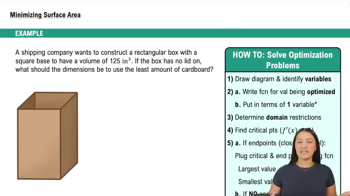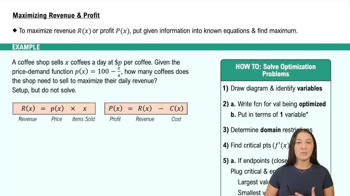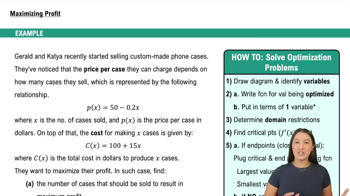Table of contents
- 0. Functions7h 52m
- Introduction to Functions16m
- Piecewise Functions10m
- Properties of Functions9m
- Common Functions1h 8m
- Transformations5m
- Combining Functions27m
- Exponent rules32m
- Exponential Functions28m
- Logarithmic Functions24m
- Properties of Logarithms34m
- Exponential & Logarithmic Equations35m
- Introduction to Trigonometric Functions38m
- Graphs of Trigonometric Functions44m
- Trigonometric Identities47m
- Inverse Trigonometric Functions48m
- 1. Limits and Continuity2h 2m
- 2. Intro to Derivatives1h 33m
- 3. Techniques of Differentiation3h 18m
- 4. Applications of Derivatives2h 38m
- 5. Graphical Applications of Derivatives6h 2m
- 6. Derivatives of Inverse, Exponential, & Logarithmic Functions2h 37m
- 7. Antiderivatives & Indefinite Integrals1h 26m
- 8. Definite Integrals4h 44m
- 9. Graphical Applications of Integrals2h 27m
- 10. Physics Applications of Integrals 2h 22m
5. Graphical Applications of Derivatives
Applied Optimization
Problem 4.5.5a
Textbook Question
Suppose the objective function P= xy is subject to the constraint 10x + y = 100, where x and y are real numbers.
a. Eliminate the variable y from the objective function so that P is expressed as a function of one variable x.
 Verified step by step guidance
Verified step by step guidance1
Start with the constraint equation: 10x + y = 100.
Solve the constraint equation for y in terms of x: y = 100 - 10x.
Substitute the expression for y from the constraint into the objective function P = xy.
This substitution gives P = x(100 - 10x).
Simplify the expression to express P as a function of x: P(x) = 100x - 10x^2.
 Verified video answer for a similar problem:
Verified video answer for a similar problem:This video solution was recommended by our tutors as helpful for the problem above
Video duration:
1mPlay a video:
Was this helpful?
Key Concepts
Here are the essential concepts you must grasp in order to answer the question correctly.
Objective Function
An objective function is a mathematical expression that defines a quantity to be maximized or minimized, often subject to certain constraints. In this case, the objective function P = xy represents a product of two variables, x and y, which we aim to optimize under the given constraint.
Recommended video:

Properties of Functions
Constraints
Constraints are conditions or limitations placed on the variables of an optimization problem. Here, the constraint 10x + y = 100 restricts the values that x and y can take, ensuring that any solution must satisfy this linear equation while optimizing the objective function.
Recommended video:

Intro to Applied Optimization: Maximizing Area
Substitution Method
The substitution method involves replacing one variable in an equation with an expression derived from another equation. In this problem, we will use the constraint to express y in terms of x, allowing us to rewrite the objective function P solely in terms of x, simplifying the optimization process.
Recommended video:

Finding Limits by Direct Substitution

 1:13m
1:13mWatch next
Master Intro to Applied Optimization: Maximizing Area with a bite sized video explanation from Callie
Start learningRelated Videos
Related Practice








